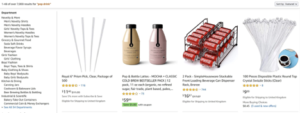The Challenges of Enterprise Ecommerce Design
23 Oct

What exactly is meant by enterprise depends on the context, but as it pertains to ecommerce, it primarily concerns scale. An enterprise ecommerce business isn’t pursuing sales as a hobby or a side project, nor is it looking to skate by on thin profit margins. Enterprise-level ecommerce is a serious business with a lot of money on the line. This article talks about the challenges of Enterprise ecommerce design.
As a result, the importance of good design is intensified for enterprise retailers. Not only is the top-end value of a conversion likely to be significantly higher, but the likelihood that the fallout from a slight misstep will snowball into a social media firestorm is much greater.
But as the importance of good design goes up, so too does the complexity involved. What are the obstacles standing in the way of finely-polished ecommerce design at an enterprise level? Let’s take a look.
Accommodating regional differences
With the prospect of national and international trade comes the difficulty of handling varying logistical and linguistic differences. When you’re running a small store, you can get very specific about the needs of your niche set of prospective customers. The moment you start trying to attract shoppers from numerous distinct locations, you introduce the risk of meeting some needs while missing others by a wide margin.
Think about how the most common search terms for a particular topic or product can be entirely different depending on where you’re searching from. If you’re searching for a carbonated beverage in the US, for instance, you might search for pop, soda, or Coke, and it’s easy to see how a large online retailer selling drinks might be slightly unsure about how to phrase its menu.
Note the Amazon search I made below. Looking for “pop” by itself returned results relating to music, as you’d expect — it’s a broad marketplace, and that’s a reasonable inference. But when I changed the search to “pop drink”, things changed. Results became largely about pop culture, with the “drink” at least making it clear that I wasn’t referring to music, but notice that soda soft drinks did make it into the list on the left-hand side, following the “Novelty & More” department.

What I can’t say is how this result varies depending on location. If you happen to live in an area of the US that chiefly refers to “pop” over “soda”, then try placing some Amazon searches with your location enabled (perhaps on mobile) and see what results you get.
Factor in the prospect of catering to multiple languages and you get more complexity still, and that’s even before you consider the logistics of local distribution networks. How do you market a specific shipping option heavily if it isn’t available in all locations? It must all be carefully mapped out to ensure that every shopper gets a good experience, regardless of where they are.
Keeping internal systems consistent
With great system size comes a great deal of extension, no matter which platform you use. Even the most comprehensive out-of-the-box system is unlikely to have every single feature an ambitious enterprise-level company will want to implement, meaning they’ll need to go down the route of hiring a developer to create extensions or using extensions already on the market.
This isn’t generally a problem, but extending a system weakens it slightly in some ways. Each new plugin or app is a fresh security vulnerability, as well as a threat to the consistency of the data and design approach, and high-end extensions are going to be more powerful than those designed for small businesses — this means that a conflict between two add-ons could cause a lot of damage and confusion.
For example, the developer behind Elementor, a WordPress page builder, identifies a selection of plugins that are known to interfere with it or even prevent it from working at all. One plugin would work but can’t be opened from the Elementor interface, requiring an alternative to be found. And with a more complex ecommerce-oriented system like Magento, using two extensions that operate in similar areas simultaneously may require some rewritten code.
In the end, the challenge is the same no matter which route you use to build a high-level store: including all the impressive features you need to optimize your UX without seeing a corresponding rise in conflicts and dip in performance (more on that next). The design process must be given adequate oversight using suitable project management tools to ensure that development proceeds as required.
Meeting stringent performance standards
Even a fairly basic hosting system can accommodate low-level ecommerce. Because small retailers can’t typically compete on price with their bigger competitors, they succeed through their customer service and unique products (often concerning specific niches), which means that the shoppers who visit their sites are more forgiving of page loading speeds, design peculiarities, and occasional errors.
At an enterprise level, an ecommerce store is expected to be the product of a careful (and expensive, if necessary) design process. The technical underpinnings are thus assumed to be rock-solid and capable of handling huge levels of traffic, and the slightest slowdown or period of downtime will make an enterprise store look incompetent or indifferent.
Consequently, investment in high-quality cloud hosting is near-mandatory: Shopify Plus and Magento are popular choices because they provide enterprise-level scalability, with the former being more consistent owing to its complete focus on the cloud and the latter being more configurable. Regardless of the specific service chosen, performance must be assured.
Standing out from the competition
The more mass appeal a company gets, the more probable it becomes that its products and methods will be noticed and imitated by other businesses. This leads to the biggest retailers (with a few exceptions) having product ranges that seem quite generic. After all, a shopper isn’t to know which company led the way for others to follow — and they’ll readily purchase from an imitator if it happens to have the most compelling value proposition.
This is certainly the case for the bulk of consumer electronics. Does shopper care which retailer was the first to stock a particular Bluetooth headset? No, of course not. They just want to get it for the best price in the right circumstances. This is why one of the biggest challenges of an enterprise-level retailer is using design to make a generic product stand out.
The right combination of imagery, creative copy, and page formatting (with a reasonable price on offer, of course) can make one listing of a common product stand out from all the others. While a niche retailer might be able to get away with a lackluster design if it happens to have a unique and eye-catching hook to its products, this isn’t the case at the enterprise level — enterprise ecommerce is far too competitive, and demands top quality from all elements.
This is what sets a company like Firebox apart. The products it sells aren’t technically innovative, but it exudes such personality through the design of its website (and presents its products in such compelling ways) that you want to get involved somehow — to experience that level of enthusiasm for yourself. I particularly love the seemingly-never-ending About Us page, because it tears up the typical formula and goes in a direction that’s at once practically pointless and truly creatively inspired.
Just as the rewards of ecommerce are so much greater at an enterprise level, so too are the hurdles to overcome. If you aspire to rapidly scale an ecommerce business, or are already running an enterprise-level store and looking for some suggestions, consider these challenges carefully to determine how you believe you can overcome them.
Related Post
Recent Posts
- MEP Document Management: How to Streamline Reviews & Avoid Rework October 3, 2025
- What Is Online Proofing Software? And Why Content Review Breaks Without It July 11, 2025
- How Laerdal Medical Cut eLearning Review Time by 50% with zipBoard’s Visual Review Tool July 9, 2025
- Why Your Team Needs a Content Feedback System (Not Just Comments in Docs) May 28, 2025
- Content Approvals Are Slowing You Down — Here’s the Fix May 26, 2025
©️ Copyright 2023 zipBoard Tech. All rights reserved.


